Over 500 million people around the world use Duolingo to learn languages. In this article, we will dive into Duolingo’s engagement strategies and how this company keeps users motivated and coming back to the app again and again.
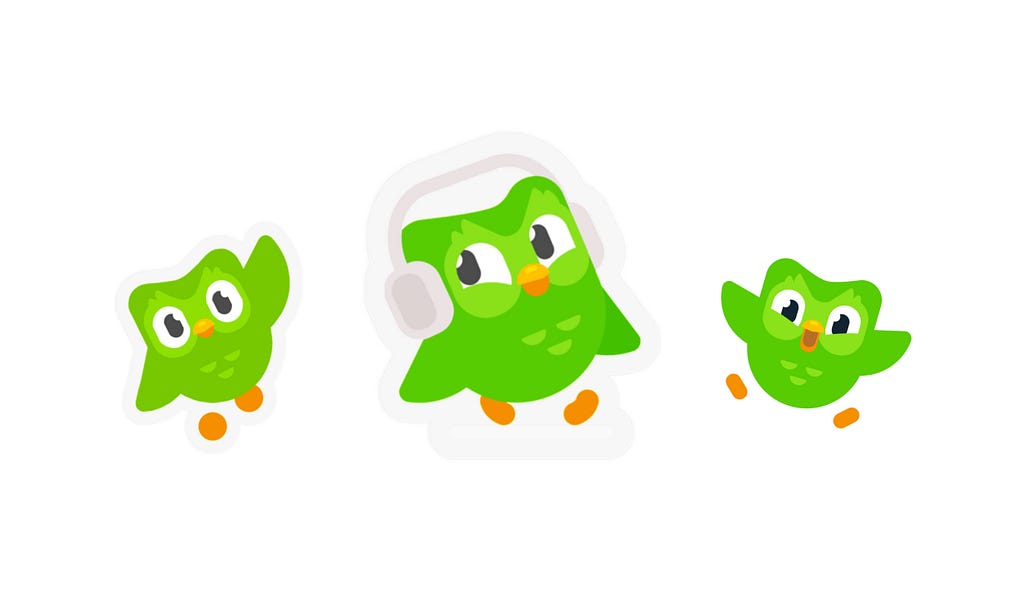
Duolingo uses the Self-Determination Theory in the product. This concept says that people are driven to learn when they feel in control, capable, and connected to others.
- Control. Users can set daily goals for a number of minutes spent in the app. This gives them a sense of ownership over their learning.
Research shows that when people feel in control of their choices, they’re more likely to persist in those behaviors, which increases retention of the app in case of Duolingo.
- Capability. Completing exercises and getting instant feedback makes users feel like they’re progressing well.
- Connection and competition. Duolingo lets users connect with others learning the same language and compete with them.
Warm welcome for users who come back
When users log back into Duolingo after a long break, the app rolls out the red carpet to welcome them back and keep them engaged. The warm welcome for returning users is designed to improve short and medium-term retention rates.
Friendly message
Users see cheerful messages encouraging them to continue their learning. It feels like a friendly nudge, reminding them that they’ve been missed. Let’s unpack what exactly is happening.
In-App Currency Reward
Users receive bonuses in the form of gems (Duolingo’s fun currency) just for logging back in. This little reward makes them want to explore the app again. After that, Duolingo clarifies the goals relevant at the moment:
- Does a user want to keep learning what they started or start something new?
- Did their goals for learning change?
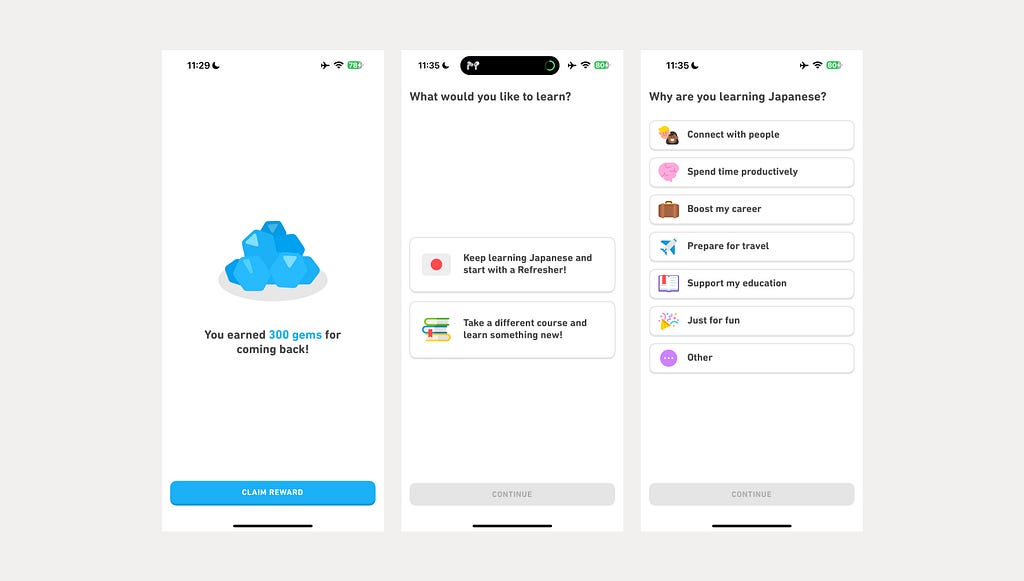
Daily Goals
The app suggests users to set daily goal to come back to the app and sends reminders to keep them on track. This highlights how important it is for Duolingo to get permission to send notifications to a user and re-engage them in this way.
Duolingo’s streak feature and daily goals encourage consistent app usage to increase retention.
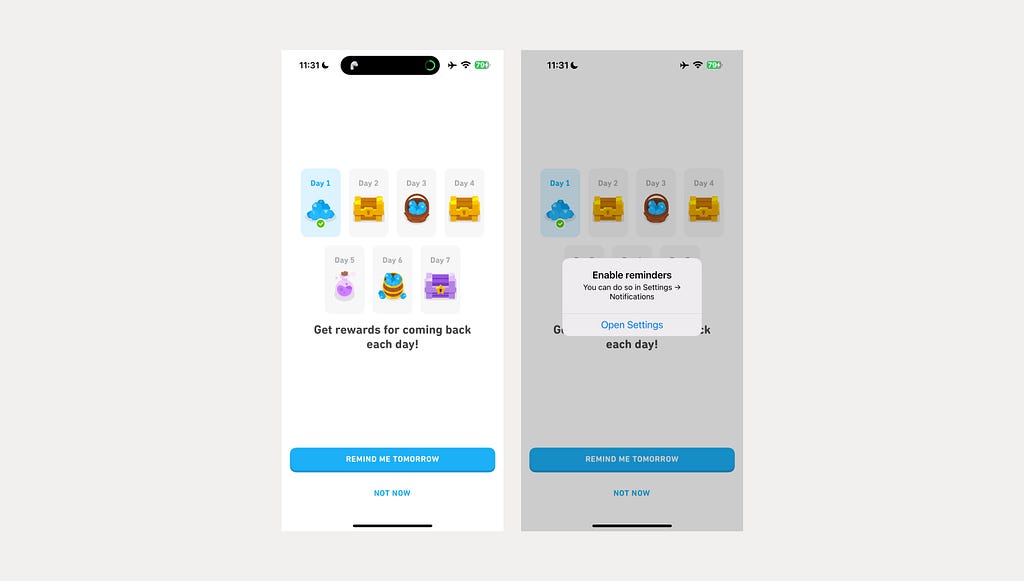
Now let’s take a look at the core engagement strategies for regular users.
Strategy 1. Gamification
Duolingo turns learning into a game with points, levels, and rewards. This approach makes users want to practice every day. In a nutshell, Duolingo uses common strategies such as:
- Points and levels. Users earn points (called XP) for completing lessons. As they earn points, they move up levels, feeling a sense of achievement. Users can use these points to unlock bonuses or special features. This reward system keeps helps establish a regular learning habit.
- Streak tracking. This feature gets into the habit loop of prompt, routine, and reward.
- Leaderboards: Users can see how they rank compared to friends and other learners. This friendly competition encourages users to practice more. Also, the ability to share achievements encourages existing users to invite friends. This viral loop helps drive organic user acquisition.
Duolingo’s rewards system
Gems: In-App Currency
What are they? Gems are Duolingo’s in-app currency that users earn as they progress. They can be used to purchase various items in the app.
Earning mechanisms
Daily practice. Users earn gems by completing lessons and maintaining streaks, which encourages consistent practice. Also, gems can be purchased in the shop: $2.99 to $11.99 for a package of gems.
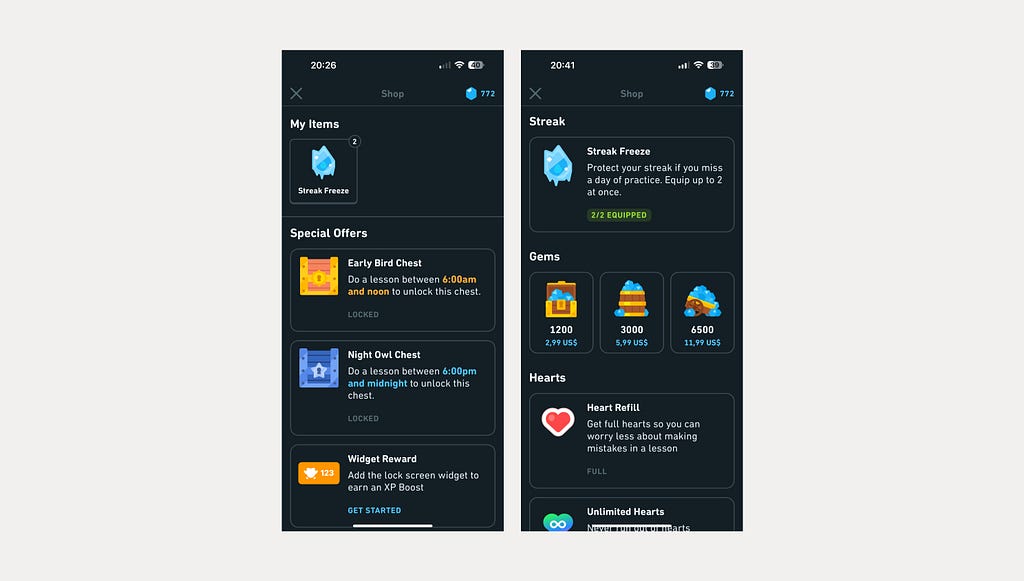
Achievement milestones. Rewards are given for reaching milestones, such as completing a certain number of lessons or achieving a high score in a lesson. Rewards are stored in a separate view accessible from the main menu in the app.
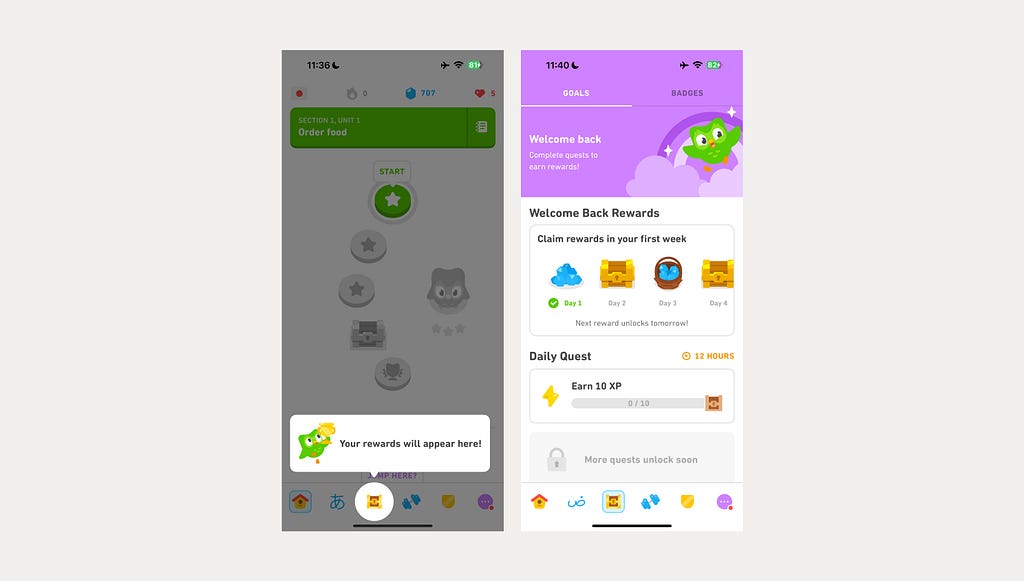
As users engage with the app and complete lessons, they accumulate experience points (XP) which contribute to their overall level.
Daily tasks
Each day Duolingo shares a to-do list of tasks a user can accomplish to win a reward. Aside from that, in “Today’s Review”, users get personalized exercise based on their recent progress.
Unpredictable rewards
Duolingo keeps users engaged by offering unpredictable rewards, like different amounts of gems or ranking boosts for completing quests tied to special events or holidays. For example, users might earn extra rewards during themed challenges around New Year’s or Halloween, keeping things exciting and fresh.
Variable Reward Theory suggests that uncertainty keeps users coming back, excited for what’s next.
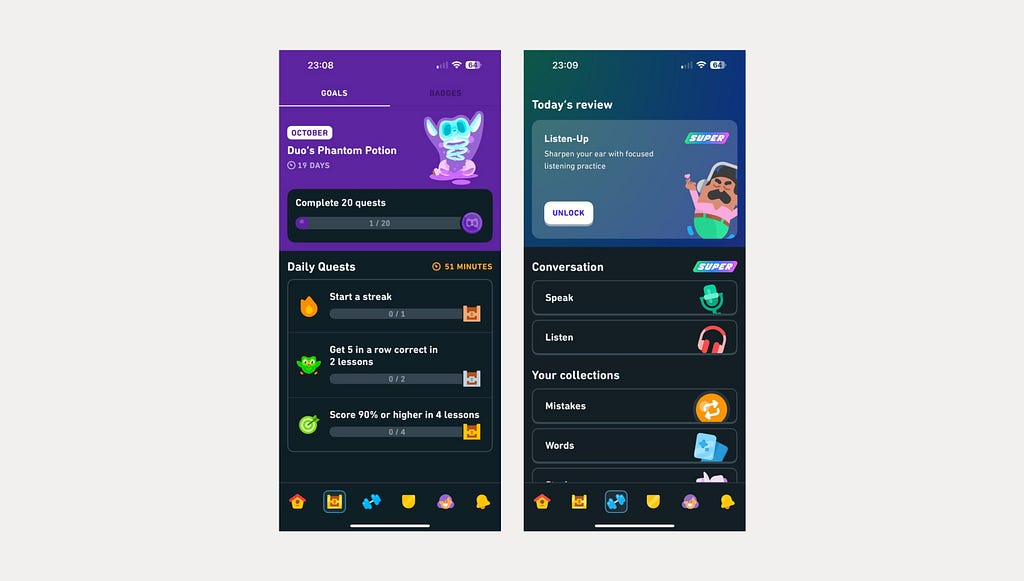
The app sometimes announces time-limited challenges where users can earn extra gems or rewards for completing specific tasks. This creates excitement and urgency, encouraging users to engage more frequently.
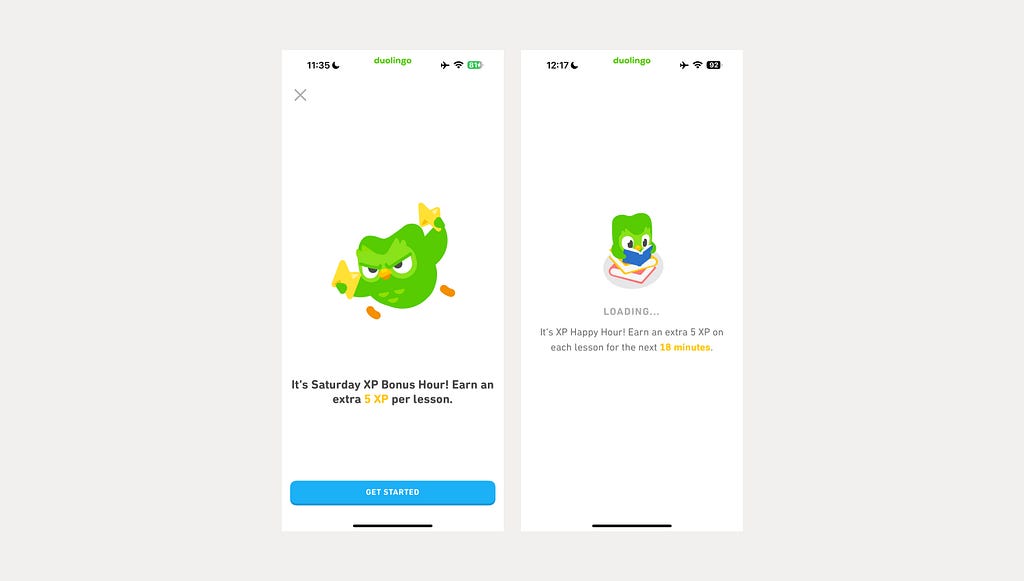
Streaks: Consistency Rewards
Duolingo places great emphasis on encouraging users to return to the app each day. Regular user activity boosts the potential for in-app purchases, ads, and subscription revenue. This makes retention a critical driver of overall profitability.
- Daily streaks. Duolingo tracks how many days in a row users practice. Users are motivated to keep their streak alive to avoid breaking it, creating a habit of daily learning. The app constantly reminds users to turn on the notifications to get reminders about using the app.
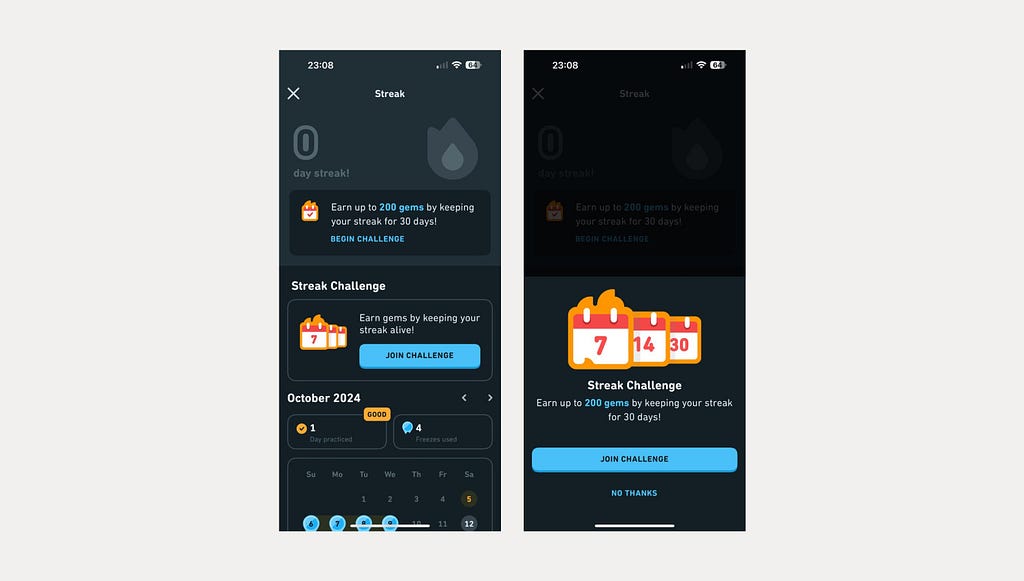
Habit Formation Theory explains that consistent prompts act as external cues, helping users develop a regular routine over time. Daily reminders help create a strong habit, making users more likely to open the app regularly.
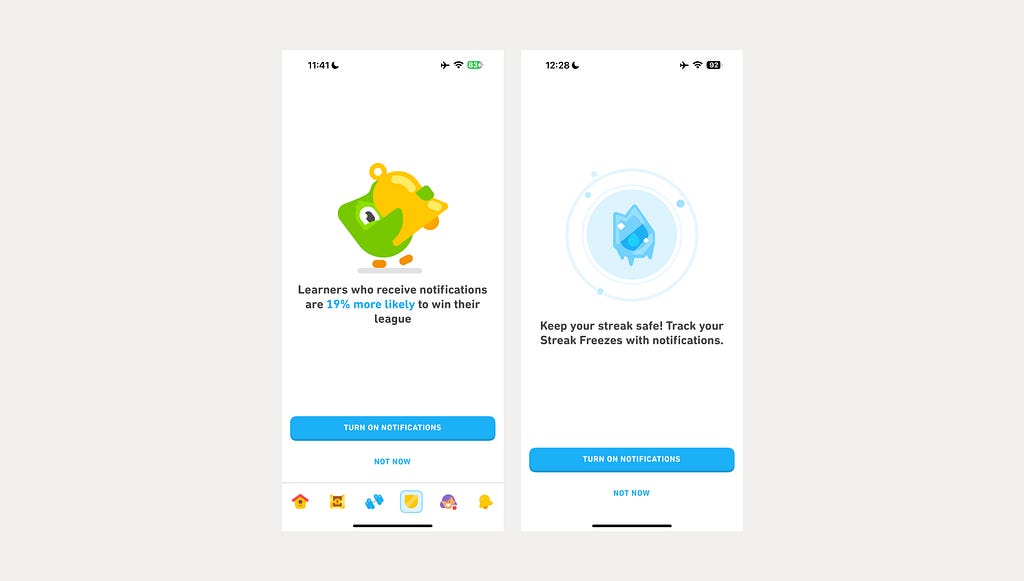
- Streak freezes. At first, users are asked to choose a length of the streak ranging from 7 to 50 days. This gives them a sense of control and responsibility for the choice. After finishing the first lesson every day users see a notification about the streak continuation and a prompt to keep going.
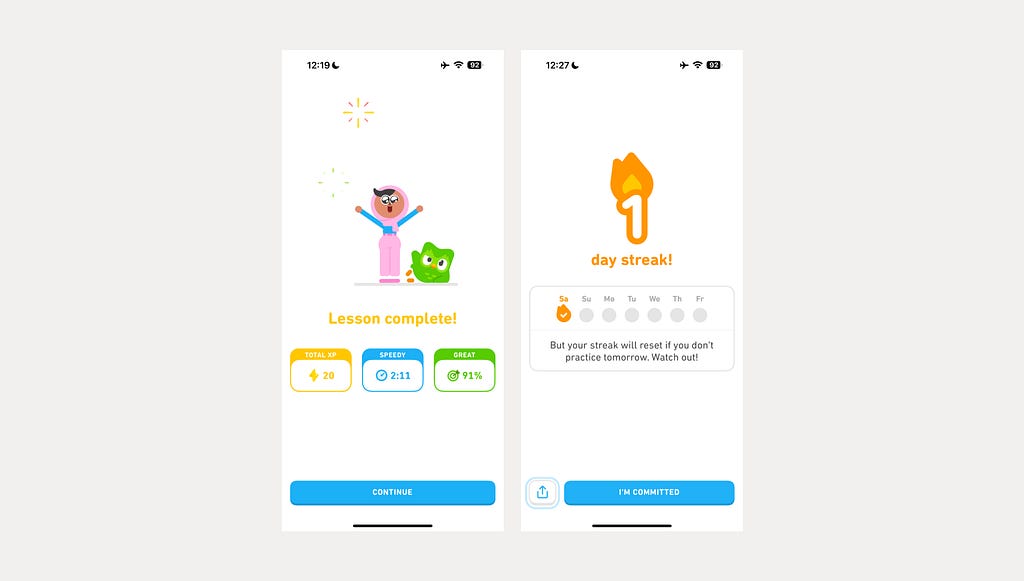
- Also, users can purchase streak freezes with gems to protect their streaks if they miss a day. This makes it safer to miss a day and prevents users from becoming demotivated due to one faulty day.
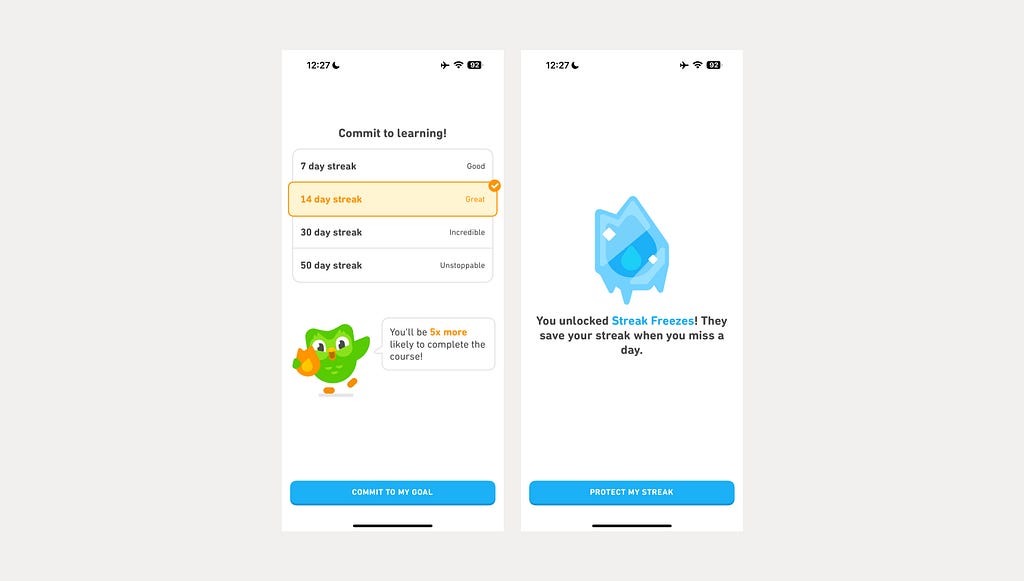
Achievement Badges: Visual Motivation
Badges for Accomplishments. Duolingo keeps users motivated by handing out badges for different milestones, like completing a certain number of lessons or leveling up.
These badges aren’t just for show — they serve as visual reminders of how far you’ve come and give you that extra sense of accomplishment. It’s a smart way to make learning feel fun, like you’re hitting milestones worth celebrating.
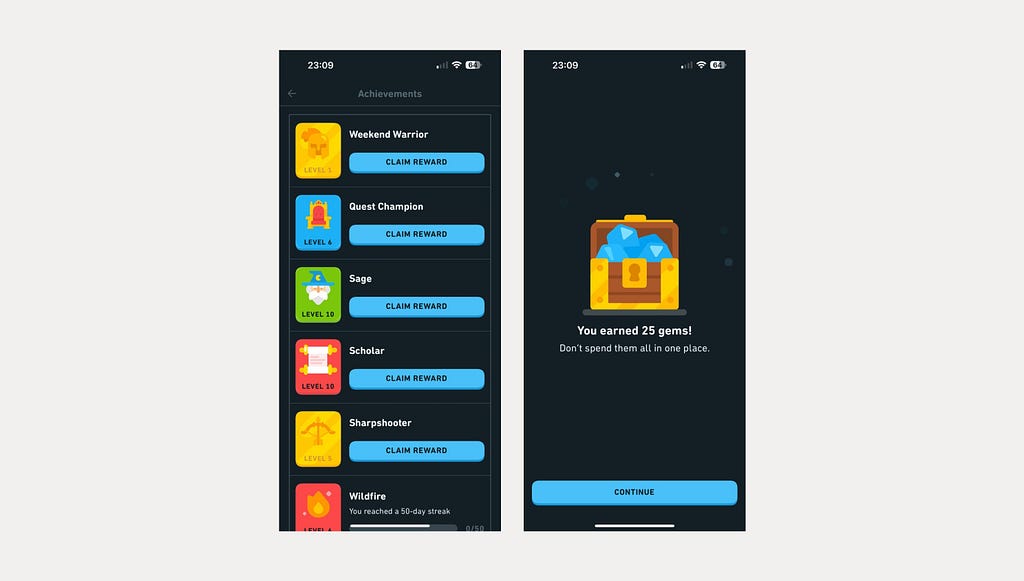
When a user taps to claim their badge, Duolingo announces that they’ve earned a specific number of gems. And it’s not just a modal — there’s a fun little animation that makes it feel like a mini-celebration. That small moment of recognition is satisfying and adds to the overall experience.
Every time users earn XP or gems, they get an instant sense of satisfaction. This draws on Positive Reinforcement Theory, where rewards trigger dopamine release, making users crave that feeling of accomplishment.
The brain loves rewards, so users keep coming back to get more, fueling consistent engagement.
Challenges and Competitions: Social Engagement
Leaderboards and sharing achievements with friends make learning social. This is linked to Social Comparison Theory, where we stay motivated by comparing our progress with others.
Duolingo has leaderboards that track users’ progress against friends and other learners. Competing for a spot on the leaderboard also adds an element of gamification.
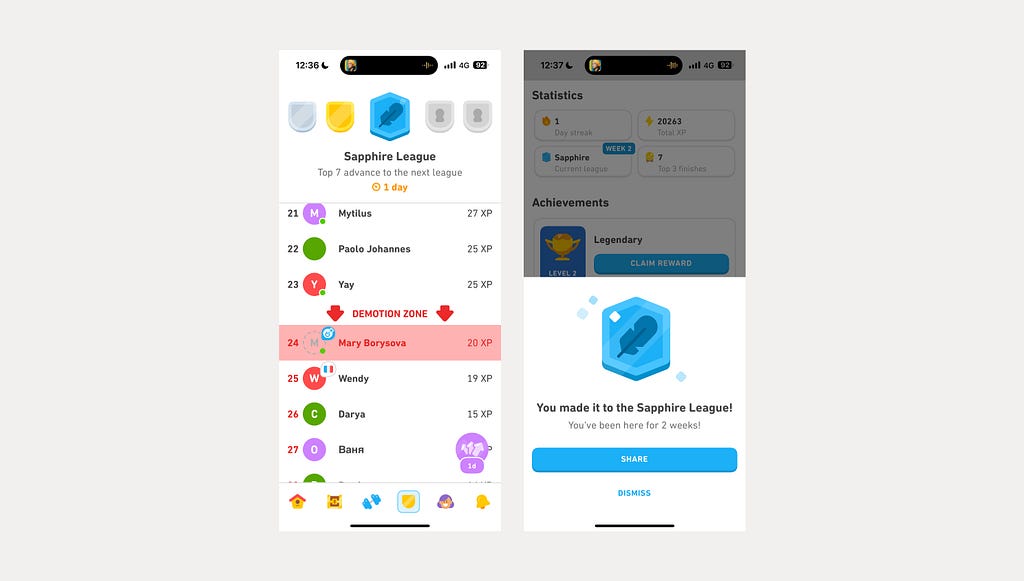
Structure of Leagues:
- Tiers of leagues. Users are placed into different leagues based on their performance, ranging from Bronze to Diamond. As users progress, they can move up to higher leagues.
- Weekly competitions. Each week, users earn points by completing lessons, practicing skills, and engaging with the app. Their performance determines their league ranking.
- Promotions and demotions. At the end of each week, the top-performing users in each league get promoted to the next tier, while those at the bottom risk being demoted to a lower league. This creates an exciting atmosphere of competition. Yet if a user dropped off the league, it’s not irreversible. Duo still gives them an opportunity to stay in the league by buying a League repair for a significant number of gems.
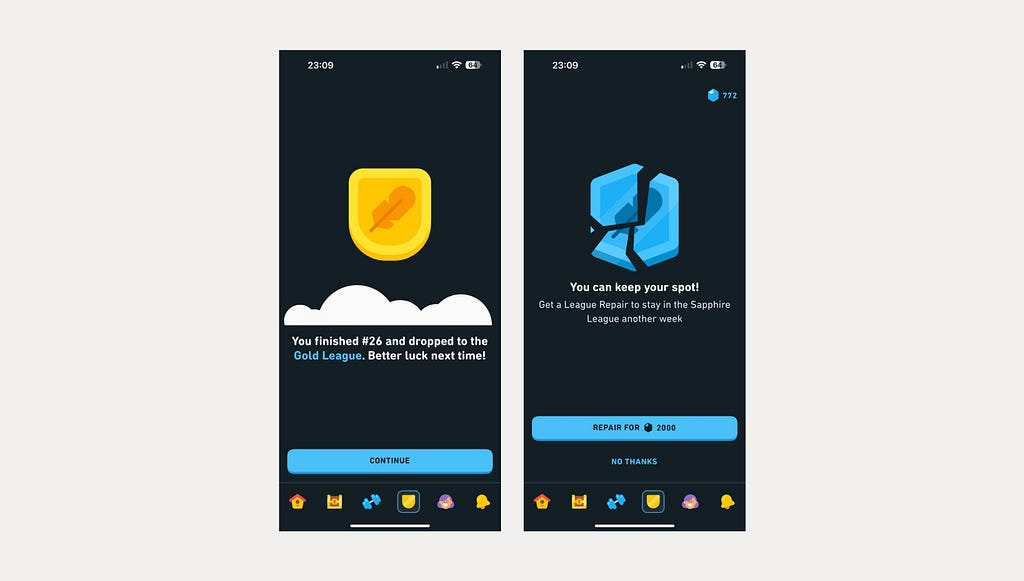
Bonus Skills and Special Features
- Bonus skills. Users can unlock bonus skills, like idioms or specific vocabulary sets, using gems. This makes the experience feel richer.
- Also, users can get gems by performing specific actions such as doing a lesson in the evening or adding a Duolingo widget to the home screen (also, a retention strategy!)
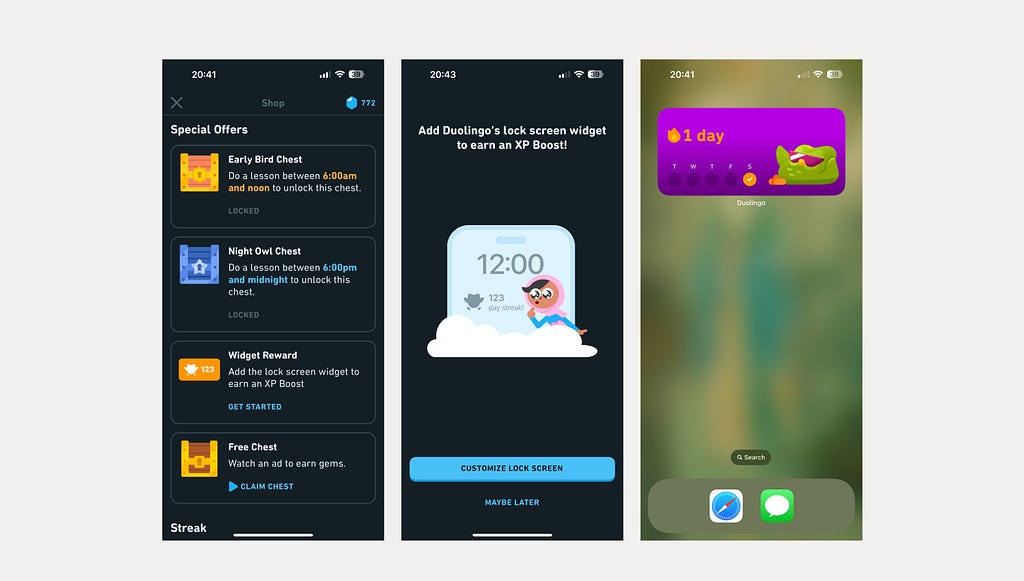
Progress Tracking and Goal Setting
Duolingo allows users to keep an eye on their progress through a visual dashboard that shows metrics like a number of points earned daily, streaks, and achievements.
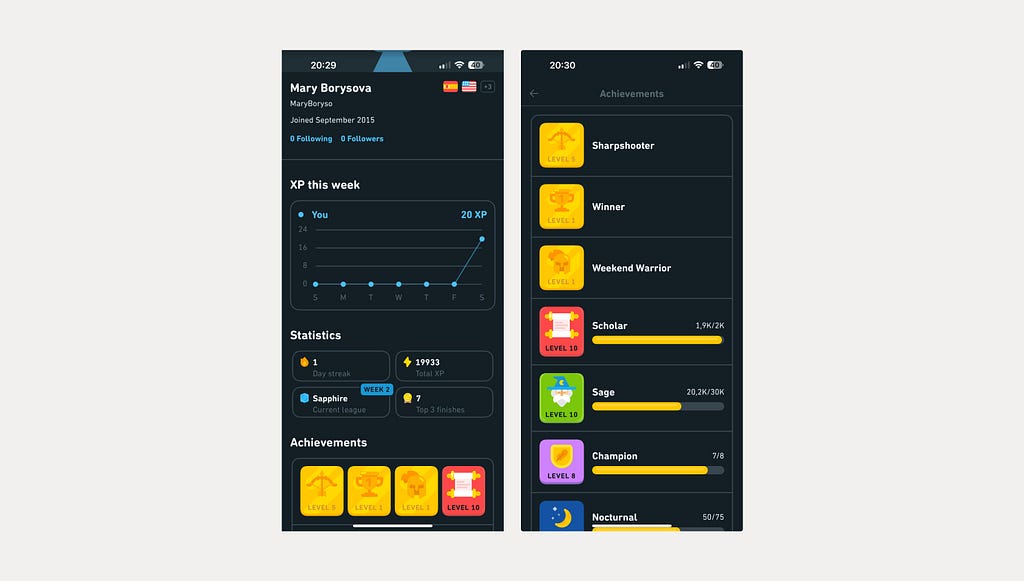
This connects with the Goal-Setting Theory, which says that clear and measurable goals lead to better performance. By showing users exactly how far they’ve come, Duolingo motivates them to keep going.
Strategy 2. Short and Easy Lessons
Duolingo uses the microlearning approach, breaking down language concepts into short, digestible lessons. This method follows the cognitive load theory, which says that we remember information better when it’s presented in smaller bites.
This is aligned with Cognitive Load Theory, which shows that breaking down tasks helps reduce overwhelm. Learning feels easy and doable, so users are more likely to stick with it over time.
By keeping each session just a few minutes long, users can easily fit language practice into their lives, reducing the chances of feeling overwhelmed by always unfinished lessons.
- Variety of exercises. The app includes speaking, listening, reading, and writing tasks. This variety keeps things fresh.
- Positive reinforcement. Rewarding correct answers keeps users motivated and reinforces successful learning habits.
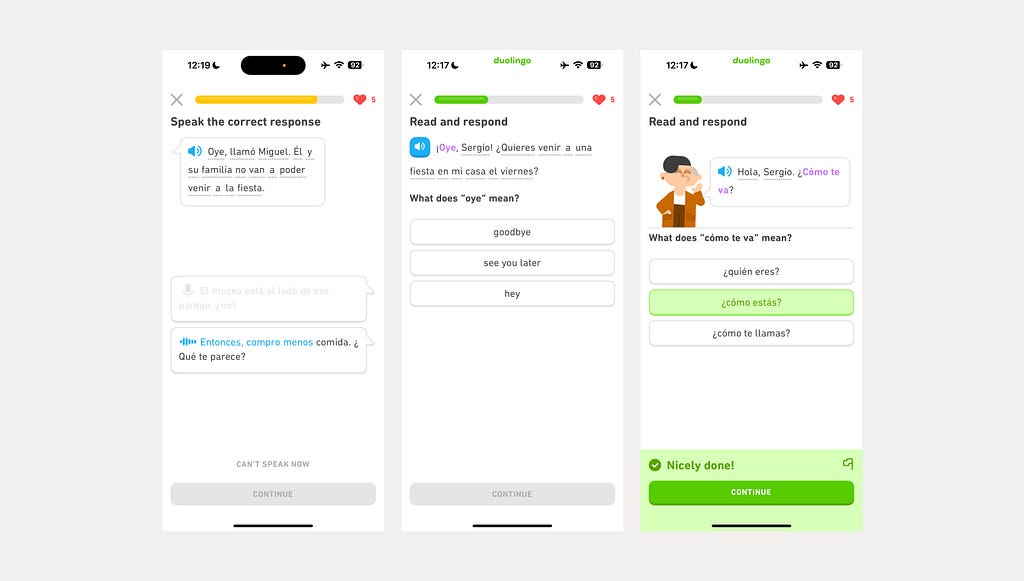
Duolingo’s instant feedback makes users feel competent by showing progress immediately, like earning badges or XP.
This relates to Operant Conditioning, where rewards for good behavior (practice) encourage users to repeat it. Feeling accomplished boosts motivation, which keeps users engaged and eager to learn more.
- Error Correction. Quick feedback helps users learn from mistakes right away.
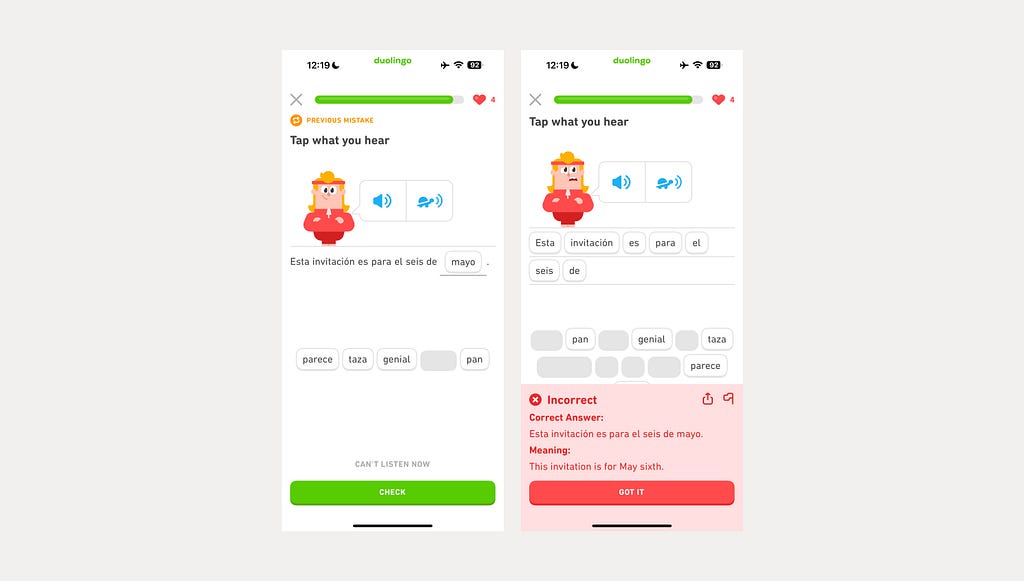
4. Adaptive learning
Duolingo uses adaptive learning algorithms to tailor lessons to each user’s strengths and weaknesses. As users progress, the app finds out weak areas and later shares tailored practices.
This connects to the Zone of Proximal Development, where learning is most effective when tasks are neither too easy nor too hard.
Personalized challenges make learning rewarding, avoiding frustration and boredom, which helps with retention.
Also, the app adjusts the difficulty of exercises, making sure that users are challenged but not feeling overwhelmed.
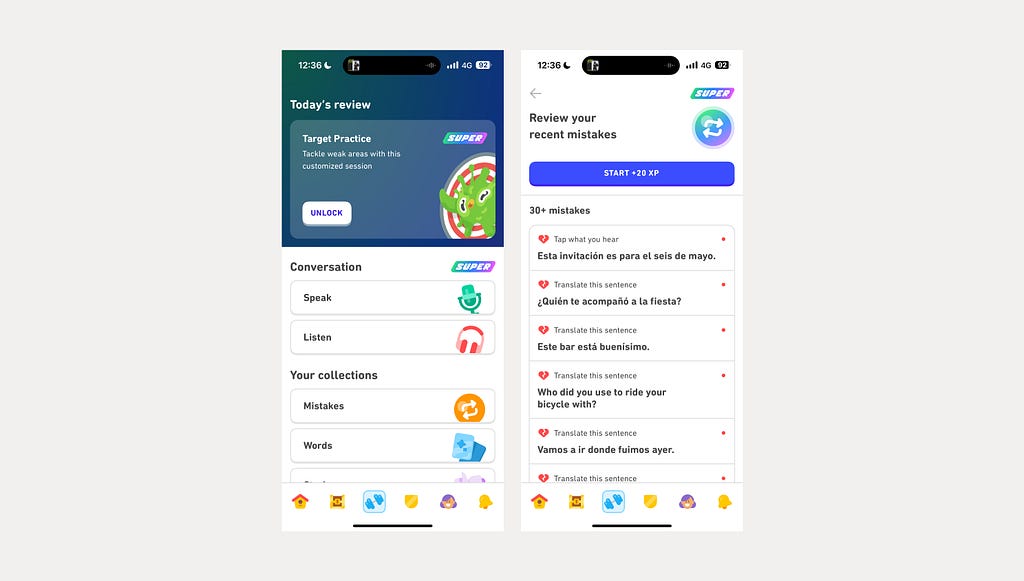
5. Cultural Insights and Engaging Content
The app includes facts about culture and traditions, making the learning experience more fun and casual. Users can read and interact with short stories in their target language.
Duolingo’s cultural insights and story modes make language learning more interesting by adding real-world context. They help create an emotional connection to the material, making users feel more engaged.
It’s similar to Narrative Engagement Theory, which shows that when people connect with a story, they’re more likely to stay focused and invested.
Then learning feels relevant and tied to real-life experiences, users are more motivated to continue, making the process more fun and meaningful.
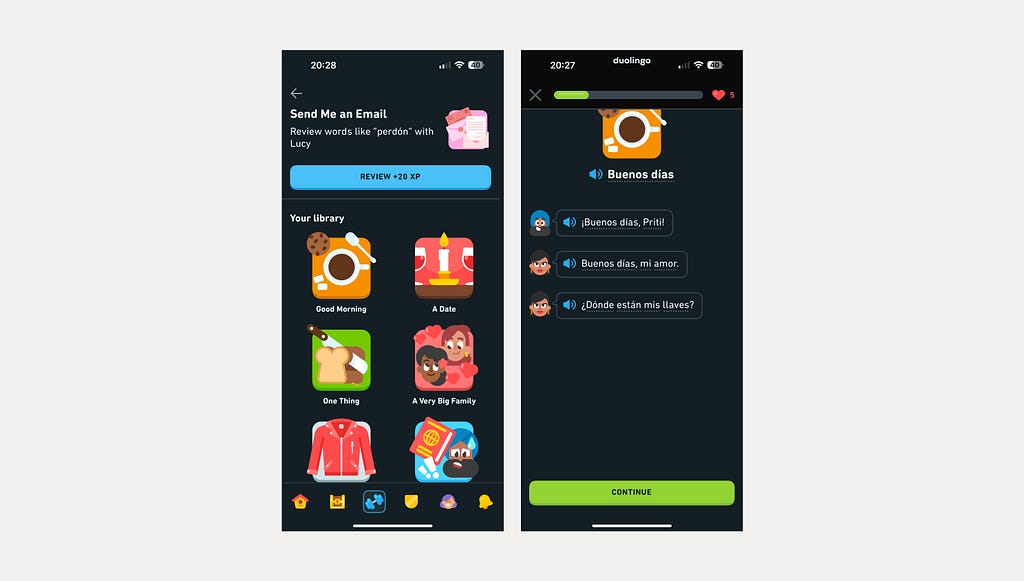
Conclusion
Duolingo is a great example of how effective design can boost user engagement and learning outcomes. It combines gamification, microlearning, and social interaction with a focus on what motivates people.
They gamify learning with points, streaks, and leaderboards that motivate users to practice daily. This approach keeps users engaged and drives up retention.
The short, varied lessons make it easy to fit language practice into busy lives without feeling overwhelmed. With adaptive learning, Duolingo tailors the experience to each user, making it more personal and satisfying.
Good luck! ☘️
If you are after more articles on design, subscribe to my Substack newsletter and connect with me on LinkedIn.
Duolingo: analyzing all engagement and retention techniques was originally published in UX Collective on Medium, where people are continuing the conversation by highlighting and responding to this story.
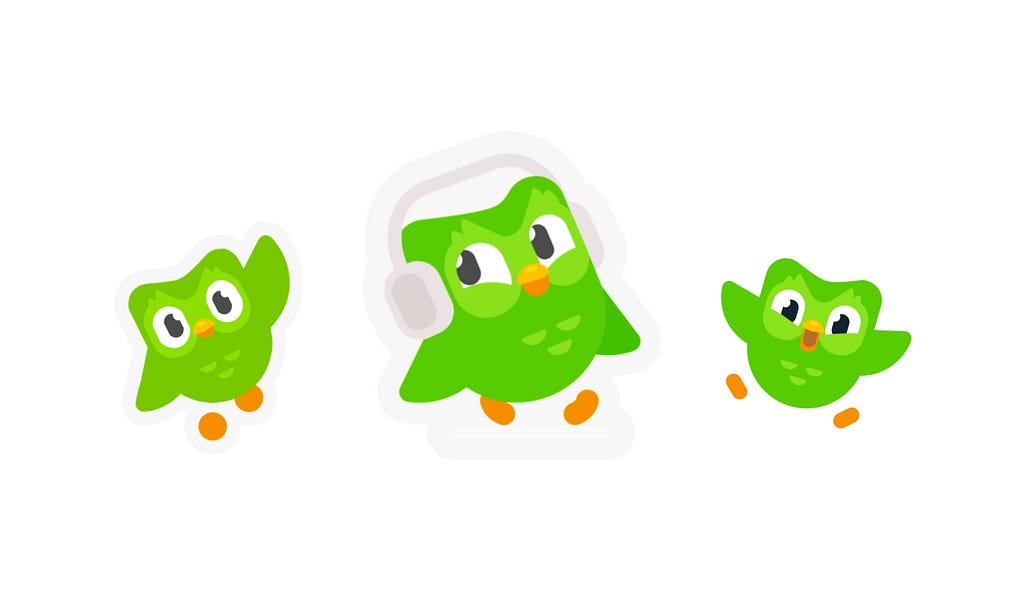
Leave a Reply